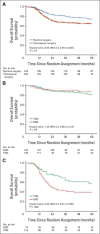Oral Cavity Carcinoma: Current Management, Controversies, and Future Directions
- PMID: 26351335
- PMCID: PMC5320919
- DOI: 10.1200/JCO.2015.61.2929
Oral Cavity Carcinoma: Current Management, Controversies, and Future Directions
Abstract
Oral cavity carcinoma (OCC) remains a major cause of morbidity and mortality in patients with head and neck cancer. Although the incidence has decreased over the last decade, outcomes remain stagnant with only a 5% improvement in overall survival in the last 20 years. Although surgical resection remains the primary treatment modality, several areas of controversy exist with regard to work-up, management of the primary and neck tumors, and adjuvant therapy. As surgical techniques evolve, so has the delivery of radiotherapy and systemic treatment, which have helped to improve the outcomes for patients with advanced disease. Recently, the addition of cetuximab has shown promise as a way to improve outcomes while minimizing toxicity, and this remains an active area of study in the adjuvant setting. Advances in microvascular free-flap reconstruction have extended the limits of resection and enabled enhanced restoration of function and cosmesis. While these advances have led to limited survival benefit, evaluation of alternative modalities has gained interest on the basis of success in other head and neck subsites. Organ preservation with definitive chemoradiotherapy, though proven in the larynx and pharynx, remains controversial in OCC. Likewise, although the association of human papillomavirus is well established in oropharyngeal carcinoma, it has not been proven in the pathogenesis or survival of OCC. Future study of the molecular biology and pathogenesis of OCC should offer additional insight into screening, treatment selection, and novel therapeutic approaches.
© 2015 by American Society of Clinical Oncology.
Conflict of interest statement
Authors' disclosures of potential conflicts of interest are found in the article online at
Figures


Comment in
-
Brachytherapy: Where Has It Gone…Again?J Clin Oncol. 2016 Apr 1;34(10):1155. doi: 10.1200/JCO.2015.65.0267. Epub 2016 Feb 16. J Clin Oncol. 2016. PMID: 26884564 No abstract available.
References
-
- Siegel R, Ma J, Zou Z, et al. Cancer statistics, 2014. CA Cancer J Clin. 2014;64:9–29. - PubMed
-
- Patel SC, Carpenter WR, Tyree S, et al. Increasing incidence of oral tongue squamous cell carcinoma in young white women, age 18 to 44 years. J Clin Oncol. 2011;29:1488–1494. - PubMed
-
- Neville BW, Day TA. Oral cancer and precancerous lesions. CA Cancer J Clin. 2002;52:195–215. - PubMed
-
- National Cancer Institute. Surveillance, Epidemiology, and End Results (SEER) Program, National Cancer Institute Surveillance Research Program, based on November 2006 submission of SEER series 9 (1996-2003) 2006.
Publication types
MeSH terms
LinkOut - more resources
Full Text Sources
Medical
Research Materials

